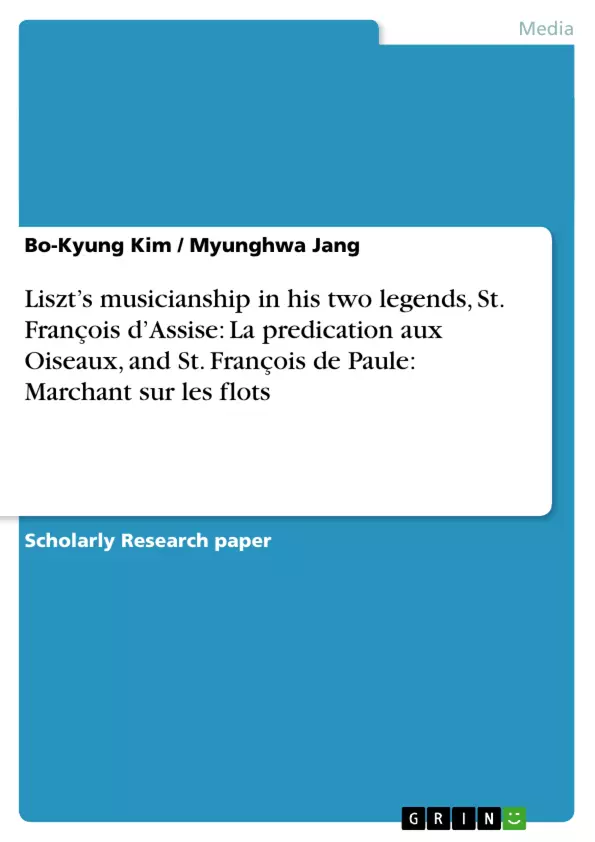Franz Liszt was born in western Hungary on October 22nd 1811 and died at Bayreuth, Germany in July 1886. He was a pianist, a teacher and a composer. He developed several musical ways such as programmatic music, technique and thematic transformation. He traveled most of his life, and composed a number of works about the places that he traveled.
He met his first lover, Countess Marie d’Agoult at the end of 1832, and they had three children, Blandine, Cosima and Daniel.
Liszt separated from Countess Marie d’Agoult in 1844, and he had met his second beloved one who took a very important role for Liszt’s life, Princess Carolyne in 1847. His only son died at age of twenty-one in 1859, and three years later, his elder daughter Blandine died at the age of twenty-six after giving birth to her first child. Liszt’s only surviving daughter, Cosima left her husband, Hans von Bülow in order to live with Richard Wagner. These three children are from Countess Marie d’Agoult. Lastly, Princess Carolyne had been trying to obtain a divorce from Prince Nicholas von Sayn-Wittgenstein in order to marry Liszt, but it was denied on the day before their planned wedding day on Liszt’s fiftieth birthday, October 22, 1861.
He spent most of the time composing religious music, and by this time he began to write some pieces for organ. He stayed at Rome for a long time and spent his elder life. He started a two-year retreat at the Madonna del Rosario, and he completed Two Franciscan Legends, St. François d’Assise: La Predication aux Oiseaux, and St. François de Paule: Marchant sur les flots in 1863. They were dedicated to his only surviving child, Cosima. Liszt had personal relationships with these two saints, and particularly he regarded St. Francis of Paul as his patron. Liszt programmed these two Francis Legends as followed ideas. These programmatic works are liked of symphonic poem in piano. The first Legend, St. François d’Assise: La Prédication aux Oiseaux (St. Francis of Assisi: The Sermon to the Birds) was inspired by the moment that the thousands of birds were easing in the cloud above the Monte Mario. The second Legend carries another miracle story: Among the many miracles of St. Francis of Paula the legend celebrated is the one which he performed crossing the Straits of Messina. The ferrymen refused to rent their boat to a person of such humble appearance; he ignored them and walked on the sea with assured step.
Inhaltsverzeichnis (Table of Contents)
- Introduction
- Liszt's Musicianship in His Two Legends, St. François d'Assise: La Prédication aux Oiseaux, and St. François de Paule: Marchant sur les Flots
- Liszt's Personal Relationships with the Two Saints
- Liszt's Programmatic Ideas
- Liszt's Performances and Saint-Saëns' Arrangement
- Public Performances by Liszt
- Saint-Saëns' Arrangement and Performances
- Liszt's Legacy and Impact
Zielsetzung und Themenschwerpunkte (Objectives and Key Themes)
This work examines Franz Liszt's musical prowess in his two legends, "St. François d'Assise: La Prédication aux Oiseaux" and "St. François de Paule: Marchant sur les Flots." The paper explores Liszt's personal relationship with the two saints and the programmatic ideas he incorporated into these compositions. Furthermore, it delves into the reception of these works through Liszt's performances and Saint-Saëns' subsequent organ arrangements. The essay aims to shed light on Liszt's legacy and the lasting impact of his music.- Liszt's musical style and his development of programmatic music
- The relationship between Liszt's life experiences and his musical compositions
- The significance of the two legends, St. François d'Assise and St. François de Paule, in Liszt's musical repertoire
- The influence of Liszt on subsequent composers, particularly Saint-Saëns
- The enduring relevance of Liszt's music in the world of classical music
Zusammenfassung der Kapitel (Chapter Summaries)
The introduction provides a brief overview of Franz Liszt's life and career, highlighting his contributions as a pianist, composer, and teacher. It contextualizes Liszt's religious music within his life and discusses his personal relationship with the two saints featured in the legends. The main focus of the work is on Liszt's two Franciscan legends, "St. François d'Assise: La Prédication aux Oiseaux" and "St. François de Paule: Marchant sur les flots". The text delves into Liszt's programmatic ideas behind these works, explaining the inspiration he drew from the miracles of St. Francis of Assisi and St. Francis of Paula.
The following section examines the reception of Liszt's legends through his public performances and Saint-Saëns' organ arrangements. The text explores Saint-Saëns' admiration for Liszt and his dedication to preserving Liszt's musical legacy. The final part of the work considers Liszt's enduring legacy and impact on subsequent composers and the world of classical music.
Schlüsselwörter (Keywords)
This preview explores key concepts including Franz Liszt, programmatic music, religious music, symphonic poem, St. Francis of Assisi, St. Francis of Paula, Camille Saint-Saëns, organ arrangement, musical legacy, and enduring impact. The discussion centers on the analysis of Liszt's musical style and the ways in which his life experiences influenced his compositions. The work highlights the significance of Liszt's two Franciscan legends and their lasting influence on the development of classical music.- Citar trabajo
- Bo-Kyung Kim (Autor), Myunghwa Jang (Autor), 2013, Liszt’s musicianship in his two legends, St. François d’Assise: La predication aux Oiseaux, and St. François de Paule: Marchant sur les flots , Múnich, GRIN Verlag, https://www.grin.com/document/207518



